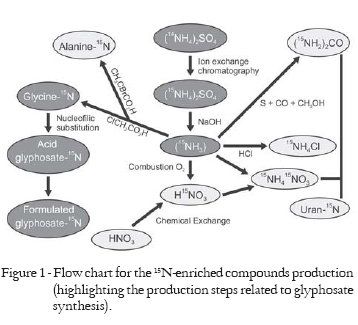Glyphosate is the herbicide with the greatest participation in the world market, and it has been used intensively in agriculture for over 30 years, especially because of its relatively low cost and high effectiveness on different species. This study describes a synthesis method of glyphosate in the form of the isopropylamine salt enriched in the stable nitrogen isotope (15N). The 15N-herbicide synthesis was performed using a phosphomethylation reaction with dialkyl phosphite and 15N-glycine. The tests were conducted at a microscale and equimolar quantities. A 20% yield was obtained at the established conditions. To test the effectiveness of the synthesized glyphosate, an experiment was performed in a growth chamber with the weed Lolium multiflorum (ryegrass), which is mentioned to be effectively controlled as indicated in package inserts ofisopropylamine salt-based products (glyphosate). The experimental design was completely randomized, with four replicates, and treatments consisted of isopropylamine salt sources at the commercial dose recommended for the product (720 g a.i. ha-1). The production of green and dry phytomass of the above-ground part and roots was evaluated 21 days after application (DAA), and the treatment toxicity was evaluated 7, 14, and 21 DAA. The isopropylamine salt sources did not differ, recognizing them as useful isotopic tracers.
Lolium multiflorum; isopropylamine salt; stable isotope














